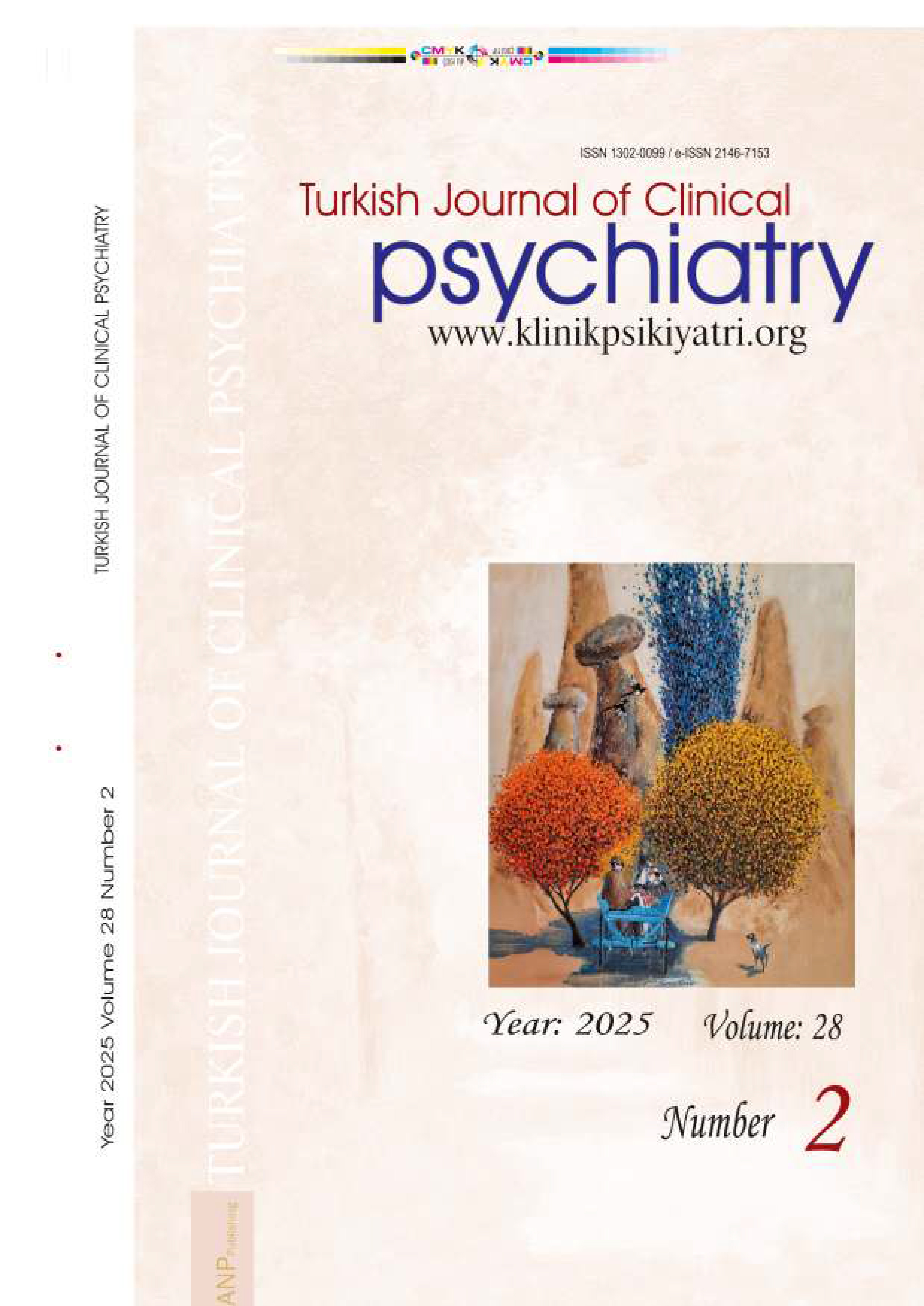





Volume: 17 Issue: 1 - 2014
| 1. | Relationships Among Stressful Life Events, Cognitive Emotion Regulation Strategies, Depressive Symptoms and Anxiety Levels Ece Temizel Ataman, İhsan Dağ Pages 7 - 17 Objectives: In this study, the relationships among stress- ful life events, cognitive emotion regulation strategies, cognitive coping styles and the level of depression and anxiety symptoms are examined. Firstly, reliability and validity of The Turkish version of Cognitive Emotion Regulation Questionnaire was examined. Method: The study was conducted in two steps. For the validity and reliability study, sample was 203 university students from various departments of Hacettepe University, and main study sample consisted of 418 university students by adding 215 students from the same university to the initial sample. The subjects were administered Turkish version of Cognitive Emotion Regulation Questionnaire, Demographic Information Form, State-Trait Anxiety Inventory, Beck Depression Inventory, Ways of Coping Inventory. Results: Results revealed that internal consis- tency of Cognitive Emotion Regulation Questionnaire and it's subscales were satisfactory. Dimensions of both of Cognitive Emotion Regulation Questionnaire and Ways of Coping Inventory were consistent. Conclusion: Based on the regression analyses, it is found that "help- less", "self confident" and "optimist " approaches explained depressive symptoms and anxiety levels. Beside this, "Acceptance" and "Positive Refocusing" were predicted the decline in depressive symptoms, while "Rumination" and "Catastrophizing" predicted the rise in anxiety scores. "Acceptance" strategy explained the decrease in the level of anxiety as it does in explaining the decrease in the level of depressive symptoms. |
| 2. | Socio-Demographic Characteristics of Suicidal Individuals Living in Malatya Hayriye Dilek Yalvaç, Burhanettin Kaya, Süheyla ÜNAL Pages 18 - 27 Objectives: The aim of this study was to investigate the risk factors and determine the socio demographic vari- ables of patients who attempted suicide in Malatya, in 2005. Method: The sample group of this research con- sisted of 50 patients who attended to the Emergency Department or other medical departments of Turgut Özal Medical Center with suicide attempt between January and April 2005 and were followed up either in or outpatient setting, and agreed to participate in the study. Patients who had psychotic symptoms and deliri- um were in the exclusion criteria. The socio-demograph- ical data sheet, Beck Depression Inventory (BDI), Beck Anxiety Inventory (BAI), Beck Hopelessness Scale (BHS) were applied following the clinical interview. Results: Of all patients, 64% were female. The mean ages of women and men were 25.9 ± 7.6 and 32.3 ± 13.7, respectively. In our study, suicide attempts were more common among married women (59.4%) and single men (55.6%). Mental disorders had started at an earlier age in singles (p=0.001), and at a later age in widows and divorced (p=0.025). While 36% of the patients were diagnosed as adjustment disorder, 32% was diagnosed as depression and only 20% did not receive any specific diagnosis. A history of suicide attempts was determined in 32% of the cases and 90% of our patients had suicide attempts with non-violent methods. Psychosocial stressors were present in 54 % of patients three months prior to the sui- cide attempt and the majority of these were family prob- lems. Conclusion: It is essential to recognize some clinic and socio-demographic characteristics related to suicide attempts and psychiatric disorders have to be treated in order to prevent suicide attempts. |
| 3. | Adulthood Obesity: A General Review for Biological and Psychological Treatment Melis Sedef KAHRAMAN, Seher Olga Güriz, Kadir Özdel Pages 28 - 40 The objective of the review is to provide general infor- mation about approaches for biological and mostly psy- chological treatments of obesity conceptualized as a dis- order which has biological, psychological and social components. Another aim of the current review is to fill the gap in the literature regarding these approaches. In order to find out the relevant literature, the search was conducted based on the Pub Med, Web of Science and Google Scholar data bases. The combination of key words consisting of "obesity", "diet", "surgery", "treat- ment", "cognitive", "behavioral", "pharmacological", and "psychotherapy" and their Turkish counterparts were used during the literature search. Up to date papers and re-testable data were included in this article. It can be concluded that various treatment modalities in treat- ment of obesity are significantly beneficial. However it does not seem to be the case that one obesity treatment is useful for everyone. It is reported that pharmacother- apy and surgical interventions were effective especially for some patient sub-groups such as the people with morbid obesity. Rather than the people with morbid obesity, the other sub-groups need multi-treatment methods. In this regard, the foremost approach which is the psychological method is required to be integrated into the treatment of obesity. Although these kind of combined interventions show favorable results, further psychological interventions should be improved for pre- vention of relapse of obesity after desired results achieved with the help of diet. When relatively long term effects of interventions are considered, public based pre- vention studies may be more promising in terms of decreasing the prevalence of obesity. |
| 4. | Diagnosis and Differantial Diagnosis of Dissociative Disorder Merve Çıkılı Uytun, Rabia Durmuş, Didem Behice Öztop Pages 41 - 48 It is known that there is a relationship between many psychiatric disorder and childhood trauma history. Dissociative disorders are most often investigated disor- ders. The common theme shared by dissociative disor- ders is a partial or complete loss of normal integration between memories of the past, awareness of identity, and immediate sensations and control of bodily move- ments. This group of illnesses also lacks the evidence of proximate organic illness or pathophysiological distur- bance, and the symptoms correspond to the ideas of the patient about how parts of body or mind malfunction or fail to function. The most important feature of dissco- ciative disorders that these disorders can affect almost every psychological function. The main features of this psychopathology includes that dissociative amnesia, depersonalization, derealization, confusion of identity and changing of identity. A number of psychiatric disor- ders, including personality disorders, either have disso- ciative disorder comorbidity or contain dissociative symptoms in their diagnostic criteria. Therefore, It is important that diagnose and diffreantial diagnose with dissociative disorders should make carefully. International Classification of Diseases (ICD-10) and Diagnostic and Statistical Manual of Mental DisordersIt is known that there is a relationship between many psychiatric disorder and childhood trauma history. Dissociative disorders are most often investigated disor- ders. The common theme shared by dissociative disor- ders is a partial or complete loss of normal integration between memories of the past, awareness of identity, and immediate sensations and control of bodily move- ments. This group of illnesses also lacks the evidence of proximate organic illness or pathophysiological distur- bance, and the symptoms correspond to the ideas of the patient about how parts of body or mind malfunction or fail to function. The most important feature of dissco- ciative disorders that these disorders can affect almost every psychological function. The main features of this psychopathology includes that dissociative amnesia, depersonalization, derealization, confusion of identity and changing of identity. A number of psychiatric disor- ders, including personality disorders, either have disso- ciative disorder comorbidity or contain dissociative symptoms in their diagnostic criteria. Therefore, It is important that diagnose and diffreantial diagnose with dissociative disorders should make carefully. International Classification of Diseases (ICD-10) and Diagnostic and Statistical Manual of Mental Disorders (DSM-IV-TR) can be use for diagnose of dissociative dis- orders. In spite of the differences between nosological status, the basic themes remain unchanged. In this con- text, our patient who after a trauma experienced in childhood and we confused about this patient's current diagnosis are explained. (DSM-IV-TR) can be use for diagnose of dissociative dis- orders. In spite of the differences between nosological status, the basic themes remain unchanged. In this con- text, our patient who after a trauma experienced in childhood and we confused about this patient's current diagnosis are explained. |
| 5. | Pulmonary Thromboembolism Associated With Risperidone: A Case Report Ebru Altıntaş, Nazan Şen, Nilgün Taşkıntuna Pages 49 - 53 There are acquired risk factors such as age, smoking, trauma, immobilation and genetic risk factors such as protein C, S and antitrombin III deficiency, disfibrinogen- emy playing role in the development of Venous Thromboembolism (VTE). Association between conven- tional antipsychotic medications and VTE has been strengthened as a result of the published studies and case reports. Specially it is known that low potency antipsychotic drugs were more associated with VTE develops than high potency antipsychotics (8). Uptill now, the risk of development VTE was limited by clozap- ine, contemporarily the association between other sec- onder generation antipsychotics especially with olanza- pine and risperidone was reported by case reports and limited studies. The biological mechanism antipsycotic induced VTE is unkown, also it is thought that putting on weight , high body mass index (BMI), sedative life style developing with the use of these drugs could be the risk factors. Atypical antipsychotics are widely used for mental disorders firstly as schizophrenia and an increased risk of adverse effects have been reported. With this case report, we wanted to draw attention to the relation between atypical APs and VTE -which some- times can cause sudden death. |
| 6. | Myxedema Coma Associated with Single Dose Intramuscular Haloperidol and Chlorpromazine Therapy Süleyman Gündüz, Hatice İmer Aras, Fatih Doğu Geyik Pages 54 - 58 To describe a case of myxedema coma (MC) associated with single dose of combination of intramuscular haloperidol and chlorpromazine. Myxedema coma, the most significant form of hypothyroidism (HT), is a rare but potentially fatal condition. The known precipitating causes of myxedema coma were ruled out in this patient, which left intramuscular medications as the likely cause. Cases of hypothyroidism caused by certain atypical antipsychotics and antidepressants are found in the lit- erature, but none was reported with single dose of intra- muscular haloperidol and chlorpromazine therapy. |










